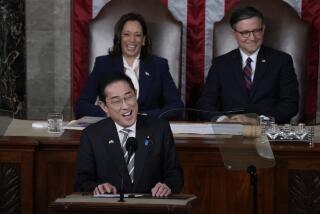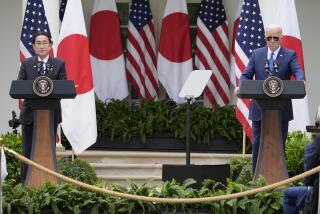U.S. Bases on Okinawa: a Case of Colonial Overlordship
- Share via
Japan’s Prime Minister Ryutaro Hashimoto has arranged a quick meeting for Feb. 24 with President Clinton in Santa Monica. It is not difficult to fathom why. The Pentagon continues to treat its deployment of 52,594 servicemen and women and their dependents in Okinawa as sacrosanct, and it is stonewalling anything other than cosmetic reductions.
Hashimoto knows that Okinawans and most Japanese want the troops out. If the Pentagon remains intransigent, conflict between Japan and the United States over this issue is unavoidable. Hashimoto will probably try to point this out to Clinton and ask for some American flexibility. However, given the lackluster interest Washington is showing these days in East Asian problems, it is likely that the president will not know the scope of the problem that the prime minister is talking about.
I visited Okinawa early this month at the invitation of Gov. Masahide Ota and saw some of the 42 American military installations on the island. I was shocked by the greedy sprawl of these American military cities and by their undisguised signs of colonial overlordship.
One of these bases, Camp Hansen, (home of the three men accused in last September’s notorious rape case) is an obscenity. It houses 5,000 Marines, squeezing the small, old town of Kin (pop. 10,000) between the sea and the concrete barracks. Hansen was built in the 1960s when Okinawa was under direct American administration, and Okinawans had to get a passport from the Americans in order to visit Japan. Today, these Americans pass the time of day firing 105-mm and 155-mm howitzers over a main prefectural road into a hill called Mt. Onna. The forest fires and soil erosion these “training” exercises have caused would not be permitted on any American firing range. The firing also causes continuous earth tremors in Kin and makes many ordinary civilian activities, such as running schools, daunting.
Okinawa is Japan’s poorest prefecture, largely because of the American presence, but it sports three of the largest and best airports in East Asia. Only one of these is open to Japanese citizens. The others, Futenma Marine Corps Air Station and Kadena Air Force Base, were built for the Cold War. While Kadena is still active, its runways were last used in war to launch B-52 bombers against Vietnam. Futenma is surrounded on all sides by the city of Ginowan, where last October 90,000 people gathered to protest its presence. These facilities need to be consolidated and reduced to fit the post-Cold War world.
Another redundant facility is the dock area at Naha, still controlled by the U.S. Army. Twenty-three years ago, Japan and the United States agreed to return these wharves in Okinawa’s capital city for civilian use but nothing was ever done. The Defense Department says it would be glad to give them back if Japan provides equivalent facilities elsewhere. But no other place in Japan is prepared to shoulder the burdens that Okinawa has had foisted on it, and the Americans could easily use public quays, as they do in other Japanese ports.
Still another emblem of the troubled Japan-U.S. relationship is the Awase golf course, with its neatly stenciled parking places reserved for colonels in one place, for Navy captains in another, and, farthest away from the first tee, for master sergeants. The place looks like a caricature of the last days of the British Raj. Japanese are allowed to play this course only if accompanied by an American serviceman. Rumor has it that President Clinton and the Pentagon plan to return either Awase or another military golf course and call this a breakthrough in base consolidation.
The only military role for the United States in East Asia today is to project power over long distances and to keep the sea lanes open in the Taiwan Strait, the South China Sea and Southeast Asia. This is the role of the U.S. 7th Fleet, which is the only truly indispensable American military force in Asia today. The main American naval base in northeast Asia is now the old Japanese base at Yokosuka on Tokyo Bay. This facility is so important that its continued security ought to be a primary American policy objective.
The main danger in America’s Asia security policy is complacent military leadership. People in the Pentagon are paid good salaries to plan military strategy. They should start producing some appropriate to the post-Cold War world.
The United States should forthwith close Camp Hansen, give back Futenma, become more sensitive to the noise and environmental pollution of Kadena while retaining it on active duty, open the Awase golf course to the public and transfer the Naha docks to Okinawan administration. Congress should also conduct full-scale hearings into the Pacific Command and its dismal record of administering the Japan-America alliance.
The American bases on Okinawa reminded me of the Russian presence in East Germany after the Berlin Wall came down. They have no continuing reason to be there but don’t want to go home.
More to Read
Sign up for Essential California
The most important California stories and recommendations in your inbox every morning.
You may occasionally receive promotional content from the Los Angeles Times.












